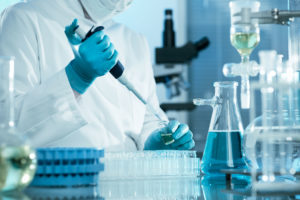Ensuring the accuracy of cannabis microbiology testing is critical for cultivators’ bottom line as well as consumer safety. Microbial contaminates are small, hard to track and easy to pick up – they’re everywhere!
The first and most important step here, unfortunately often overlooked, is collecting the sample in its original environment and in a sterile fashion. Here at PureVita Labs, our founders are PhD chemists and medical doctors, one of whom is a surgeon (who knows a thing or two about sterile environments). Our sample collection SOPs (standard operating procedures) are designed with similar aseptic techniques used in hospital operating rooms. The cannabis samples are collected using these sterile aseptic techniques and placed in a pre-sealed sterile container, only opened once on site, and them immediately sealed again on site before leaving. 
The sample is then placed in a locked cooler. Then the cooler is placed in a locked container, which is, you guessed it, locked to the frame of our transportation vehicle (very secure!). And then transported directly back our laboratory. No stops are allowed on the way back of course, and this is all tracked in real-time by a state-of-the art cloud-based GPS system monitored by our lab (and the state!)
Once arrived back in the lab the sample is checked into our internal lab tracking software system, making use of bar codes and scan guns, while the sample remains in its sealed sterile container. One of our microbiology analysts is notified and moves the sample, still in its sealed sterile container, to our microbiology lab room.
PureVita’s Microbiology Lab is state-of-the-art and hospital-grade, and in an individual room separated from all other testing equipment (as are all of our lab rooms). Anyone entering must enter through an airlock room, which is monitored 24/7 with a manometer, confirming that there is always positive pressure in the airlock. Our microbiology lab is a clean room with plaster ceilings and a fan-powered Hepa filer cleaning all the air that enters the room (but of course all the air that enters our building already passes through carbon air filters and Hepa filters – so the air entering our micro lab gets cleaned twice!).
Then, finally, our microbiologist gets to open the sample … but only after the sample is brought over to our specialized bio-safety cabinet. This piece of equipment has a glass shield drawn over the front of it, leaving space for the analyst to place their arms under the glass to handle the sample. It is also equipped with an “air curtain” – there is a curtain of air that constantly flows on the inside of the glass to keep all contaminants in the bio-safety cabinet (this air is then sent through filters before being reintroduced into the cabinet) … and a curtain of air on the outside of the glass to keep any outside contaminants from getting into the bio-safety cabinet, where the sterile sample is being handled, to prevent the introduction of any outside contamination. There is only one sample open at a time in the bio-safety cabinet to prevent cross-contamination between samples. All the sample prep work is performed under the bio-safety cabinet, and the sample is sealed again, and never opened until the test is complete. Further, the cabinet, the surfaces, and all the equipment is sprayed and wiped down with alcohol in between sample analysis sessions. Finally, the bio-safety cabinet is also equipped with a digital monitor that controls and measures the air curtain rate, filtration, and performance.
It’s an exhaustive process that requires specialized equipment, people, and processes. These are the standards we are setting and measures we take to ensure our customers get accurate results. PureVita Labs – advancing the science of cannabis.
